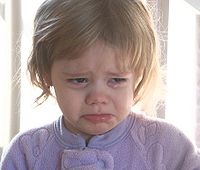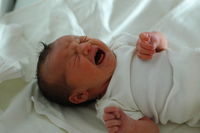Crying


Crying (also called sobbing, wailing, weeping, bawling, and blubbering) is shedding tears as a response to an emotional state in humans. The act of crying has been defined as "a complex secretomotor phenomenon characterized by the shedding of tears from the lacrimal apparatus, without any irritation of the ocular structures".[1] The medical term for this is to lacrimate, which also refers to non-emotional shedding of "tears".
A neuronal connection between the lacrimal gland (tear duct) and the areas of the human brain involved with emotion was established. No other animals are thought to produce tears in response to emotional states,[2] although this is disputed by some scientists.[3]
According to a study of over 300 adults, on average men cry once every month; women cry at least five times per month,[2] especially before and during the menstrual cycle when crying can increase up to 5 times the normal rate, often without obvious reasons (such as depression or sadness).[4] In many cultures, it is more socially acceptable for women and children to cry, and less socially acceptable for men to cry.[2]
Tears produced during emotional crying have a chemical composition which differs from other types of tears. They contain significantly greater quantities of hormones prolactin, adrenocorticotropic hormone, Leu-enkephalin[5] and the elements potassium and manganese.[2]
Contents |
Function
The question of the function or origin of emotional tears remains open. Theories range from the simple, such as response to inflicted pain, to the more complex, including nonverbal communication in order to elicit "helping" behaviour from others.[6]
In Hippocratic and medieval medicine, tears were associated with the bodily humours, and crying was seen as purgation of excess humours from the brain.[7] William James thought of emotions as reflexes prior to rational thought, believing that the physiological response, as if to stress or irritation, is a precondition to cognitively becoming aware of emotions such as fear or anger.
William H. Frey II, a biochemist at the University of Minnesota, proposed that people feel "better" after crying, due to the elimination of hormones associated with stress, specifically adrenocorticotropic hormone.[8] This, paired with increased mucosal secretion during crying, could lead to a theory that crying is a mechanism developed in humans to dispose of this stress hormone when levels grow too high.
Recent psychological theories of crying emphasize the relationship of crying to the experience of perceived helplessness.[9] From this perspective, an underlying experience of helplessness can usually explain why people cry. For example, a person may cry after receiving surprisingly happy news, ostensibly because the person feels powerless or unable to influence what is happening.
Emotional tears have also been put into an evolutionary context. One study proposes that crying, by blurring vision, can handicap aggressive or defensive actions, and may function as a reliable signal of appeasement, need, or attachment.[10]

Types of crying in infants
Although crying is an infant's only way of communication, it is not limited to one monotone sound. There are three different types of cries apparent in infants. The first of these three is a basic cry, which is a systematic cry with a pattern of crying and silence. The basic cry starts with a cry coupled with a briefer silence, which is followed by a short high-pitched inspiratory whistle. Then, there is a brief silence followed by another cry. Hunger is a main stimulant of the basic cry. An anger cry is much like the basic cry; however, in this cry, more excess air is forced through the vocal cords, making it a louder, more abrupt cry. The third cry is the pain cry, which, unlike the other two, has no preliminary moaning. The pain cry is one loud cry, followed by a period of breath holding. It is important to note that most adults can determine whether an infant's cries signify anger or pain (Zeskind, Klein & Marshall, 1992). Most parents also have a better ability to distinguish their own infant's cries than those of a different child.[11]
There has been some evidence that crying between cultures also has some differences. In western countries such as Canada, the United Kingdom, and the United States, babies cry more than infants in Eastern European countries. East Asian and Southeast Asian babies cry the most in the world, while African babies cry less than anywhere in the world. This is due to an intense amount of crying in the first three months after birth, with periods of crying peaking in the fifth week of age. It is unknown why this difference occurs culturally.[12] A recent study has revealed that babies mimic their parents' pitch contour. French infants wail on a rising note while the Germans favor a falling melody.[13]
- Bell's palsy, where faulty regeneration of the facial nerve can cause sufferers to shed tears while eating.[14]
- Cri du chat, where the characteristic cry of affected infants, which is similar to that of a meowing kitten, is due to problems with the larynx and nervous system.
- Familial dysautonomia, where there can be a lack of overflow tears (alacrima) during emotional crying.[15]
- Pathological laughing and crying, where the patients experience relatively uncontrollable episodes of laughing or crying, or both.
References
- ↑ V. Patel, Crying behavior and psychiatric disorder in adults: a review, Compr. Psych. 34 (1993) 206– 211. Quoted by Michelle C.P. Hendriks, A.J.J.M. Vingerhoets in Crying: is it beneficial for one’s well-being?
- ↑ 2.0 2.1 2.2 2.3 Why do we Cry, Walter, Chip, Source: Scientific American Mind; December 2006, Vol. 17 Issue 6, p44, 8p, ISSN 1555-2284
- ↑ Frey, WH. Crying: the Mystery of Tears. Chapter 14: Do Animals Shed Emotional Tears? pp. 135-139
- ↑ Fischer, Agneta (2000). Gender and Emotion: Social Psychological Perspectives. ISBN 9780521639866. http://books.google.com/?id=tS1C8Sl5ysEC&pg=PA158&lpg=PA158&dq=women+cry+during+menstrual.
- ↑ Skorucak A. "The Science of Tears." ScienceIQ.com.
- ↑ On the Origin of Crying and Tears, Human Ethology Newsletter, Vol. 5 Issue 10, June 1989, p. 5-6
- ↑ Lutz (2001), 69ff.
- ↑ "Crying; The Mystery of Tears" personal page of Frey WH with quote from his book
- ↑ Miceli, M., & Castelfranchi, C. (2003). Crying: discussing its basic reasons and uses. New Ideas in Psychology, 21(3), 247-273.
- ↑ New Theory for Why We Cry
- ↑ Santrock, John. (2008). Crying. In Fourth Edition A Topical Approach To Life-Span Development (pp.351-352) New York, NY. McGraw-Hill
- ↑ Barr, Ronald. Keefe, Maureen. Roberts, Ian St. James. (2001). New Evidence On Unexplained Infant Crying: Its Origins, Nature, and Management. Johnson & Johnson Pediatric Institute.
- ↑ Newborns' Cry Melody Is Shaped by Their Native Language
- ↑ [Crocodile tears syndrome] [Acta Otorrinolaringol Esp. 1990 May-Jun] - PubMed Result
- ↑ Felicia B Axelrod and Gabrielle Gold-von Simson (October 3, 2007). "Hereditary sensory and autonomic neuropathies: types II, III, and IV". Orphanet Journal of Rare Diseases 2 (39): 39. doi:10.1186/1750-1172-2-39. PMID 17915006. PMC 2098750. http://www.ojrd.com/content/2/1/39. Retrieved 2008-11-04.
Further reading
- Frey, William H.; Langseth, Muriel (1985). Crying: The Mystery of Tears. Minneapolis: Winston Press.
- Lutz, Tom (1999). Crying: The Natural and Cultural History of Tears. New York: W.W. Norton. ISBN 0-393-04756-3.
- Walter, Chip (December 2006). "Why do we cry?". Scientific American Mind 17 (6): 44.
External links
- "Boys don't cry?" - Damian Corless examines the taboo that still surrounds public crying, Irish Independent, 8 August 2008.
- Why we cry by John-Paul Flintoff, The Age, 30 August 2003.
- It's No Party, But I'll Cry if I Want To by Gina Stepp, Vision Media, 14 January 2009.
|
|||||||||||||||||